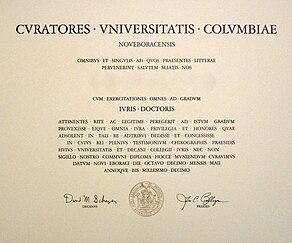
Back دكتوراه في القانون Arabic Juris Doctor BCL Juris Doctor Catalan Juris Doctor German Juris doctor Spanish جیدی Persian Juris Doctor French Juris Doctor Italian 法務博士(専門職) Japanese 법무박사 Korean

A Juris Doctor, Doctor of Jurisprudence,[1] or Doctor of Law[2] (JD) is a graduate-entry professional degree that primarily prepares individuals to practice law. In the United States, it is the only qualifying law degree. Other jurisdictions, such as Australia, Canada, and Hong Kong, offer both the postgraduate JD degree as well as the undergraduate LL.B., BCL, or other qualifying law degree depending on the requirements of the jurisdiction where the person will practice law.
Originating in the United States in the late 19th century, the JD is the most common law degree in the country. The degree generally requires three years of full-time study to complete and is conferred upon students who have successfully completed coursework and practical training in legal studies. The JD curriculum typically includes fundamental legal subjects such as constitutional law, civil procedure, criminal law, contracts, property, and torts, along with opportunities for specialization in areas like international law, corporate law, or public policy. Upon receiving a JD, graduates must pass a bar examination to be licensed to practice law. The American Bar Association does not allow an accredited JD degree to be issued in less than two years of law school studies.[3][4]
In the United States, the JD has the academic standing of a professional doctorate (in contrast to a research doctorate),[5][6] and is described as a "doctor's degree – professional practice" by the United States Department of Education's National Center for Education Statistics.[7][8] In Australia, South Korea, and Hong Kong, it has the academic standing of a master's degree,[9][10] while in Canada, it is considered a second-entry bachelor's degree.[11][12]
To be fully authorized to practice law in the courts of a given state in the United States, the majority of individuals holding a JD degree must pass a bar examination,[13][14][15][16] except from the state of Wisconsin.[17][18] The United States Patent and Trademark Office also involves a specialized "Patent Bar" which requires applicants to hold a bachelor's degree or the equivalent in certain scientific or engineering fields alongside their Juris Doctor degree in order to practice in patent cases —prosecuting patent applications — before it.[19] This additional requirement does not apply to the litigation of patent-related matters in state and federal courts.
- ^ "The Doctor of Jurisprudence (JD) Degree". Stanford Law School. Archived from the original on 6 July 2022. Retrieved 9 April 2023.
- ^ "The Law School > Academic Catalog | The University of Chicago". Graduate Announcements, The University of Chicago. Archived from the original on 15 June 2023. Retrieved 15 June 2023.
- ^ "JD Program & Policies". University of Washington School of Law. Archived from the original on 23 September 2008. Retrieved 2 September 2008.
- ^ Russo, Eugene (2004). "The changing length of Ph.D.s". Nature. 431 (7006): 382–383. Bibcode:2004Natur.431..382R. doi:10.1038/nj7006-382a. PMID 15372047. S2CID 4373950.
- ^ Time to degree of U.S. research doctorate recipients (Report). NSF InfoBrief, Science Resource Statistics. Vol. 06–312. U.S. National Science Foundation. 2006. p. 7. Archived from the original (PDF) on 8 March 2016 – mentions that the J.D. is a "professional doctorate", in § 'Data notes'
- ^ "Ethics Opinion 1969-5". San Diego County Bar Association. 1969. Archived from the original on 11 April 2003. Retrieved 26 May 2008 – describes differences between academic and professional doctorates; contains a statement that the J.D. is a professional doctorate, in § 'Other references'.
- ^ Structure of U.S. Education: First professional degrees (DOC). National Center for Education Statistics (Report). U.S. Department of Education. April 2020. Archived from the original on 14 December 2020. Retrieved 15 December 2020. NCES discontinued the use of the term "first professional degree" as of its 2010–2011 data collection.
- ^ The Condition of Education. National Center for Education Statistics (Report). U.S. Department of Education. § Glossary. Archived from the original on 31 December 2020. Retrieved 15 December 2020.
- ^ Cite error: The named reference
AQF titleswas invoked but never defined (see the help page). - ^ "Regulation of the Legal Profession in South Korea: Overview". Practical Law. Retrieved 6 December 2023.
- ^ McMahon, Kirsten (January 2008). "Making the grade" (PDF). Canadian Lawyer. Archived from the original (PDF) on 22 July 2015. Retrieved 7 July 2015.
- ^ Cite error: The named reference
Canadian Frameworkwas invoked but never defined (see the help page). - ^ "North Carolina Board of Law Examiners (NCBLE) 919-848-4229". NCBLE. 20 March 2017. Archived from the original on 10 May 2017. Retrieved 17 April 2017.
- ^ "VBBE – Welcome". Barexam.virginia.gov. Archived from the original on 18 April 2017. Retrieved 17 April 2017.
- ^ "Admission requirements". California Bar exam. Archived from the original on 14 September 2010. Retrieved 24 September 2010.
- ^ "Bole – Official Page New York State Bar Examination". NY bar exam. Archived from the original on 9 May 2017. Retrieved 17 April 2017.
- ^ School, University of Wisconsin Law. "Diploma Privilege | University of Wisconsin Law School". law.wisc.edu. Archived from the original on 9 April 2023. Retrieved 9 April 2023.
- ^ "Diploma Privilege | Marquette University Law School". law.marquette.edu. Archived from the original on 9 April 2023. Retrieved 9 April 2023.
- ^ United States Patent and Trademark Office (27 March 2017). "Becoming a Patent Practitioner". USPTO.gov. United States Government. Archived from the original on 5 June 2022. Retrieved 3 November 2021.
Learn about applying for registration to practice in patent matters before the USPTO, including requirements, forms, and exam information.